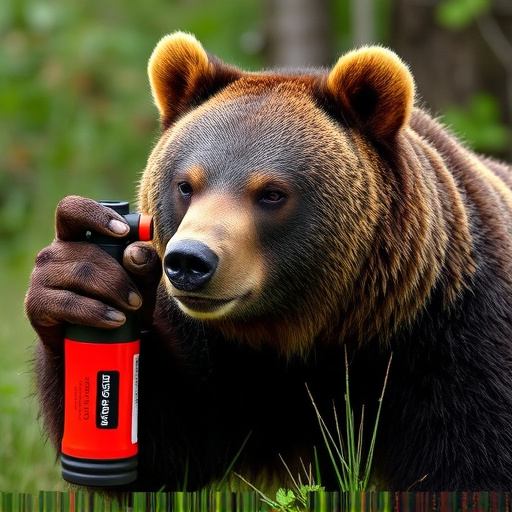Bear spray protects against bear attacks through capsaicin and pyrethrins which irritate their senses. Proper usage, understanding chemical compositions like capsaicin, and responsible storage are vital for safety in bear country while minimizing environmental impact. Choosing bear spray involves considering ingredients for optimal effectiveness during encounters with bears.
“Wildlife encounters can be awe-inspiring, but some interactions pose risks, especially with bears. Enter bear spray—a powerful tool designed to deter and protect against unexpected encounters. This comprehensive guide explores the essentials of bear spray, from its chemical composition to safety practices. We delve into the science behind effective chemicals, offering insights on what makes these solutions successful. Additionally, we cover environmental considerations, selection tips, and proper usage instructions for this lifesaving tool.”
- Understanding Bear Spray: A Lifesaving Tool
- The Science Behind Effective Chemicals
- Safety Measures: Proper Use and Storage
- Environmental Impact and Conservation
- Choosing the Right Bear Spray for You
Understanding Bear Spray: A Lifesaving Tool
Understanding Bear Spray: A Lifesaving Tool
Bear spray, also known as bear repellent, is a crucial tool for anyone venturing into bear country. Unlike traditional pyrotechnic devices like whistles or bangers, which may startle bears but offer little protection in close encounters, bear spray provides a safe and effective means of self-defense. At its core, bear spray is designed to deter aggressive behavior from bears by targeting their sense of smell.
The active ingredients in bear spray vary, but common chemicals include capsaicin, similar to what’s found in chili peppers, and other irritants. When sprayed directly into a bear’s face, these substances create an unpleasant sensory experience, prompting the bear to retreat. It’s important to understand that while bear spray can be a lifesaver, it’s not 100% reliable. Proper usage, including knowing the distance and angle, is essential for maximizing its effectiveness during potential encounters with bears.
The Science Behind Effective Chemicals
The effectiveness of bear spray lies in the powerful chemicals it contains, carefully formulated for maximum impact. Key active ingredients often include capsaicin, a compound derived from chili peppers, and various types of pyrethrins, natural insecticides produced by chrysanthemums. These chemicals work together to create a disorienting and painful experience for bears, temporarily blinding them and causing respiratory distress.
When used correctly, bear spray creates a barrier of chemical agents that can deter aggressive encounters. The specific combination and concentration vary among brands, but the science behind these compounds ensures their reliability in potentially life-saving situations. Understanding what chemicals are in bear spray is crucial for users to make informed decisions when choosing protection for their outdoor adventures.
Safety Measures: Proper Use and Storage
When it comes to safety measures, understanding what chemicals are in bear spray is paramount. Bear spray typically contains capsaicin, the active ingredient found in chili peppers. This irritant creates a painful and temporary blindness in the eyes of the target animal, giving you valuable time to retreat or defend yourself.
Proper use and storage are crucial. Always follow the instructions on the can, ensuring a safe distance from both yourself and others when spraying. Store bear spray out of reach of children and pets, in a cool, dry place, and check expiration dates regularly. Remember, proper handling and knowledge of its components are key to making sure bear spray serves its purpose effectively during an encounter.
Environmental Impact and Conservation
Wildlife encounters, especially with bears, can be life-changing events. While bear spray has become a popular tool for self-defense, it’s crucial to consider its environmental impact and role in conservation efforts. The effectiveness of bear spray relies on specific chemicals that create a barrier between the user and the bear, but these same chemicals also pose potential risks to ecosystems.
Understanding what chemicals are in bear spray is essential. Common ingredients include capsaicin, oleoresin capsicum, and various preservatives. While these substances are derived from natural sources, their concentrated forms can have detrimental effects on non-target wildlife and water bodies if not used responsibly. Conservationists advocate for the responsible use and disposal of bear spray to minimize ecological impact. Additionally, ongoing research aims to develop more environmentally friendly alternatives, ensuring that wildlife encounters can be safely managed while preserving the balance of nature.
Choosing the Right Bear Spray for You
When considering bear spray, one of the most important factors is understanding what chemicals are inside. Active ingredients can vary, with capsaicin (from chili peppers) and pepper-based sprays being the most common. These ingredients create a burning sensation in the animal’s eyes and nose, causing them to back away.
Other options include spray containing oleoresin capsicum (OC), which is derived from chili peppers and often considered more potent than capsaicin alone. Some brands also incorporate additional chemicals like 2-pyridinecarboxylic acid (PCA) or citral for enhanced effectiveness. Understanding the composition allows you to select the best bear spray for your needs, taking into account factors like scent detection, wind conditions, and desired level of protection.
Bear spray is a valuable tool for anyone venturing into bear country, offering a non-lethal means of self-defense against aggressive bears. By understanding the active chemicals, proper usage techniques, and environmental considerations, you can make an informed decision when choosing the right bear spray for your needs. Remember, knowledge and preparation are key to ensuring safe interactions with these majestic creatures. Stay informed, stay safe, and respect the wild.
